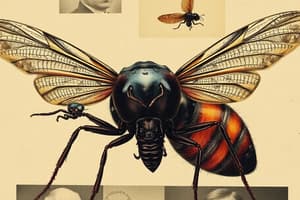Podcast
Questions and Answers
Which type of mouthpart does a honey bee possess?
Which type of mouthpart does a honey bee possess?
- Chewing lapping mouthparts (correct)
- Sponging sucking mouthparts
- Siphoning sucking mouthparts
- Chewing mouthparts
What orientation describes mouthparts that are pointed forward?
What orientation describes mouthparts that are pointed forward?
- Hypognathous
- Paranathous
- Prognathous (correct)
- Opisthognathous
Which type of antennae is characterized by being abruptly clubbed?
Which type of antennae is characterized by being abruptly clubbed?
- Clavate
- Capitate (correct)
- Pectinate
- Filiform
What characteristic helps insects escape predators efficiently?
What characteristic helps insects escape predators efficiently?
Which type of antennae has a comb-like structure?
Which type of antennae has a comb-like structure?
Which characteristic is NOT associated with members of the Arachnida class?
Which characteristic is NOT associated with members of the Arachnida class?
What is the primary diet of millipedes?
What is the primary diet of millipedes?
Which of the following statements about centipedes is true?
Which of the following statements about centipedes is true?
Which part is NOT found on the head of an insect?
Which part is NOT found on the head of an insect?
What is a defining feature of insects' exoskeletons?
What is a defining feature of insects' exoskeletons?
Which of the following structures is found in the mouthparts of grasshoppers?
Which of the following structures is found in the mouthparts of grasshoppers?
Which classification includes spiders, ticks, and scorpions?
Which classification includes spiders, ticks, and scorpions?
What type of eyes do insects possess that are referred to as 'simple eyes'?
What type of eyes do insects possess that are referred to as 'simple eyes'?
Flashcards
Exoskeleton
Exoskeleton
Hard, protective outer layer found in arthropods, primarily made of chitin.
Chitin
Chitin
A fibrous, complex sugar that forms the exoskeleton of arthropods.
Classes of Arthropods
Classes of Arthropods
A grouping of similar organisms based on shared characteristics. Arthropods are classified into classes like Arachnida, Diplopoda, Chilopoda, and Insecta.
Arachnida
Arachnida
Signup and view all the flashcards
Head of an Insect
Head of an Insect
Signup and view all the flashcards
Antennae
Antennae
Signup and view all the flashcards
Labrum
Labrum
Signup and view all the flashcards
Mandibles
Mandibles
Signup and view all the flashcards
Siphoning sucking mouthparts
Siphoning sucking mouthparts
Signup and view all the flashcards
Chewing lapping mouthparts
Chewing lapping mouthparts
Signup and view all the flashcards
Prognathous head
Prognathous head
Signup and view all the flashcards
Moniliform antenna
Moniliform antenna
Signup and view all the flashcards
Capitate antenna
Capitate antenna
Signup and view all the flashcards
Study Notes
Arthropoda Characteristics
- Arthropods have an exoskeleton made of chitin
- Their bodies are segmented
- They have segmented appendages
- They exhibit bilateral symmetry
- They have a dorsal tubular heart
- Their nerve chord is ventral and paired
Classes of Arthropods
- Arachnida: Spiders, mites, ticks, scorpions
- Diplopoda: Millipedes
- Chilopoda: Centipedes
- Insecta: Insects
Arachnida Characteristics
- Arachnids have bodies divided into two parts
- They have four pairs of legs
- They lack antennae
- They lack wings
Chilopoda (Centipedes)
- Centipedes have longer antennae than millipedes
- They are flattened in cross-section
- Each segment has one pair of legs
- They are beneficial predators, preying on other arthropods
- They move quickly
- They have poison glands and can inflict painful bites
Diplopoda (Millipedes)
- Millipedes feed on fungi and decaying plants
- They can damage plants
- They have two pairs of legs per segment
- Their bodies are divided into two parts (head and body)
- They are round in cross-section
- They move slowly
Insect Identification
- Insects are a subclass of arthropods that can be identified from the image provided.
Cuticle
- Insect exoskeletons are formed from epithelial cell layers that produce chitin, proteins, fats, and pigments
- The cuticle has layers, including the epicuticle, exocuticle, and endocuticle
Insect Head Parts
- Genae (Cheeks): The sides of the insect head
- Compound Eyes: Multi-faceted eyes
- Ocelli (Simple Eyes): Smaller, simpler eyes
- Antennae: Sensory appendages
- Clypeus: Part of the head, located below the frons
- Frons: The front of the head
- Mouth: The structures for feeding
- Labrum: Upper lip
- Mandibles: Jaw-like structures
- Maxillae: Parts of the mouth
- Labium: Lower lip
Types of Mouthparts
- Chewing: Grasshoppers have chewing mouthparts
- Piercing-Sucking: Mosquitoes have piercing-sucking mouthparts
- Sponging: House flies have sponging mouthparts
- Siphoning: Butterflies have siphoning mouthparts
- Chewing-Lapping: Honeybees have chewing-lapping mouthparts
Orientation of the Head
- Prognathous: Mouthparts point forward
- Hypognathous: Mouthparts point downward
- Opisthognathous: Mouthparts point backward
Types of Antennae
- Setaceous: Bristle-like (e.g., Dragonflies)
- Filiform: Thread-like (e.g., Cockroaches, Ground Beetles)
- Moniliform: Bead-like (e.g., Termites)
- Serrate: Saw-toothed (e.g., Click beetles)
- Clavate: Gradually clubbed (e.g., Carrying beetles)
- Capitate: Abruptly clubbed (e.g., Butterflies)
- Pectinate: Comb-like (e.g., Male Glow-worms)
- Geniculate: Elbowed (e.g., Ants, Weevils)
- Lamellate: Nested plates (e.g., Scarab Beetles, June Bugs)
- Pulmose: Feather-like (e.g., Mosquitoes, Male Moths)
- Aristate: Pouch-like with lateral bristles (e.g., Flies)
Antennal Structure
- Antennae consist of scape, pedicel, and flagellum
Why Insects are Successful
- Hard and light exoskeletons
- Small body size
- Ability to fly
- Short life cycles and rapid reproduction
Studying That Suits You
Use AI to generate personalized quizzes and flashcards to suit your learning preferences.




